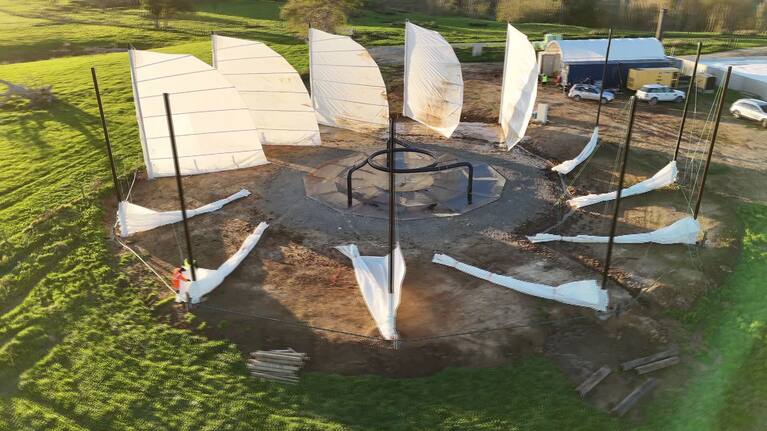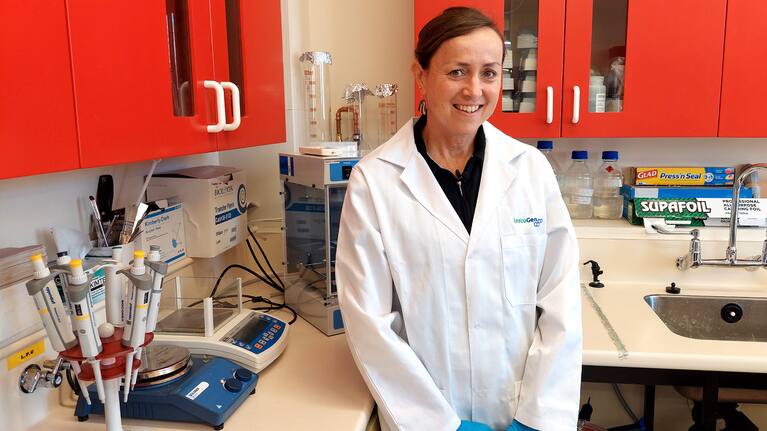Deep tech is big sky thinking that could transform our economy with processes that disrupt regular industrial methods. But, as Sunday’s Tania Page found out, it requires a lot of money and a steady hand as — with any ground-breaking developments — there are setbacks and challenges along the way.
On the outskirts of Gisborne, down a gravel road, in the middle of a farm and on top of a hill where a year ago cows were grazing, you’ll find a world first venture and a very proud professor of mechanical engineering, Richard Flay.
“It will be the tallest man-made thing on the planet, several kilometres tall,” he said.
The health and safety hazard sign on the gate warns of hot water and sails, but even with those clues nothing prepares you for the sight of it.
A giant boiler, a concrete pool of hot water, 12 tall steel poles and accompanying sails — or swirl vanes, as they’re called. In the centre, a ring of black pipes from where warm water is sprayed.

Flay still holds his professorship at the University of Auckland but he’s officially retired to dedicate himself to his work as the chief scientific officer and co-founder of Vortex Power Systems.
The idea is that they will use waste heat from industrial processes like power stations, timber mills and steel factories as fuel to create a vortex that will spin a turbine and generate electricity.
Deep tech is big-sky thinking that could transform our economy with processes that disrupt regular industrial methods.
“All those industrial processes and power plants all around the world are producing waste heat at the moment that is being dumped into the sea, into rivers, or cooling towers,” Flay said.
It’s taken a decade, $5.5 million of investment and a lot of duck fat, literally, to get to this point.
On the day Sunday arrived, he was high up in a tele-arm transporter painting the poles with duck fat for lubrication to enable the swirl vanes to be hoisted smoothly.
Each little triumph is a step in the right direction to a man-made vortex.
“How tall it is will depend on the atmospheric conditions, but maybe five kilometres. It will go in the Guinness book of records.”
He’s almost certain it will work.
“I don’t think any engineer is ever 100% confident, but we are up in the 90s. We wouldn’t be doing all of this if we weren’t confident.”

Dairy milk powder without cows
Daisylab is a deep tech company based at Outset Ventures in the heart of Auckland. It’s an all-woman crew who have figured out how to make milk powder without cows.
It’s possible using precision fermentation which has been used for decades to make insulin, vanilla essence and rennet — for cheese.
Co-founder and chief executive Irina Miller said that once milk powder, our biggest dairy export product, can be mass produced it will be a game changer.
“You don’t need green pasture, you don’t need land, you need minimal water. It can have quite serious implications for our exports because just overnight they might not be required.”
But for now the technology is locked in the lab because it uses genetic modification and a process perfected by co-founder and chief operations officer Emily McIsaac.
“It sounds a lot scarier than it is,” she said. “We take a friendly micro-organism, something like baker’s yeast, and then you take a piece of DNA. That DNA encodes for the protein you want to produce.”
Because of the very specific conditions McIsaac has created which enable the microorganism to live, it can’t survive outside the fermenters and she said there’s no trace of it in the final product.
Miller is still positive the company will thrive, despite the local restrictions.
“Our plan is actually not necessarily to sell bulk ingredient proteins, our plan is actually to sell the technology, our knowledge.”
But both women acknowledge that consumers and farmers may find the technology threatening although McIsaac said there’s no way they’ll be able to replace whole milk from cows, they’re just able to produce the individual proteins.
Dairy giant Fonterra is already investing in similar technology overseas and Miller said it could be 10 years before milk protein powders can be mass produced but we can’t afford to be left behind.
“It could be threatening to farmers to have this technology, but it would be even more threatening not to have it.”
For the Government’s part, Minister of Science, Innovation and Technology Judith Collins is planning to introduce a bill to Parliament by the end of the year to update our regulations.
“I am committed to better enabling, encouraging and embracing key areas of science, technology and innovation that have the potential to take New Zealand to the next level,” Collins said.
“Biotechnology has the potential to deliver enormous benefits for New Zealand, from combating climate change and making advances in health science to lifting agricultural productivity and boosting exports — an effective regulator, along with the right settings for researchers and organisations, will help build the industry while also assuring world-class standards and managing ethical concerns.”

Unbeatable anti-doping test
Alison Heather, professor of Physiology at the University of Otago and the chief scientific officer and co-founder of InstituteGen is well used to taking on big challenges as a 13-time Ironman.
Her elite fitness competitions were motivation for her deep tech company.
“Even if in a small way, the InsituGen technology can help make sure that we’ve got a clean sport I feel like, I’m giving back to society,” she said.
She’s figured out how to catch designer steroid users with a test that’s relatively cheap and easy.
“In terms of being able to have a rapid, easy to use kit that can tell you in a couple of hours what’s in your sample, we’re definitely a world first.”
At the moment it is used on racing horses and camels, in Aotearoa, Australia and the United Arab Emirates. There are plans, eventually, for it to be used on human athletes. But there are a lot more regulations to work through before that will be possible.
“The regulatory hurdles that we need to overcome to make sure that it’s safe and that it’s ethical to use across the human sports requires a lot more capitalisation,” Heather said.
“So instead of talking in the low millions, we’re talking in the high millions.”
Even so two-legged athletes can benefit as several sports supplement companies have their products shipped to Heather’s team for testing. That gives athletes piece-of-mind they’re not taking anything they shouldn’t, accidentally.
Her technology is also highly versatile and is being used by vets to give wellness tests to pets, tracking their hormone levels so owners can stay across any changes and health concerns.
For Heather, the secret to taking a university research project into a fully-fledged company comes down to the fact she built something that was fit for purpose.
Like all of these innovative projects, the potential is there to propel our economy into a new stratosphere. But none of it will come easily — or cheap.






